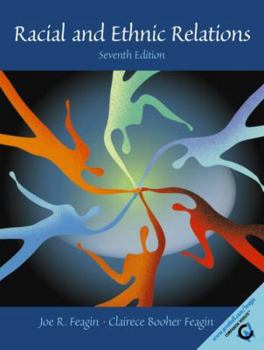Racial and Ethnic Relations
Select Format
Select Condition 
Book Overview
Examining the social, economic, and political realities to racial and ethnic relations Racial and Ethnic Relations, 9/e examines the "what", "why", and "how" of racial and ethnic oppression and... This description may be from another edition of this product.
Format:Hardcover
Language:English
ISBN:0130995339
ISBN13:9780130995339
Release Date:January 2002
Publisher:Pearson College Div
Length:592 Pages
Weight:2.38 lbs.
Dimensions:10.3" x 1.0" x 8.0"
Customer Reviews
2 ratings
Good basic survey on various U.S. ethnic groups
Published by Thriftbooks.com User , 20 years ago
Joe Feagin is one of America's foremost scholars in the area of racial/ethnic conflict and inequality. His latest textbook, "Racial and Ethnic Relations," is a very informative book detailing the multicultural history of the United States and the populating of the country by various ethnic groups from colonial days up to the present. What do I like about this book? First off, Feagin provides an extremely detailed ethno-historical account for many different groups. You simply have to open up the book and read to see what I am talking about. Second, Feagin provides a very good, in-depth account of the early colonial era in America. He discusses the English/British migrations in the 17th and 18th centuries and how this colonizing population established the Anglo-Saxon cultural core which became the dominant, standard American culture that all other immigrant and ethnic groups were measured to. This is extremely important because far too often, sociology/anthropology coures on this subject matter ignore that social construction of racial categories and racial thinking - assuming, erroneously, that such categories are a priori. This is utterly wrong and historically inaccurate. The Irish in the 19th century and Eastern Europeans in the early 20th century originally were viewed as members of distinct races. During this period in history, the racial category "white" was used to denote White Anglo-Saxon Protestants; Jews, Poles, and Catholics were regarded as racially inferior and intellectual lessers than WASPs. It was not until after World War II that white ethnic Americans came to be incorporated as full members of the "white" race. Third, Feagin includes a chapter on Arab Americans. Few textbooks of this nature incorporate an extensive analysis of Arab Americans, but Feagain's book is an exception to this trend. In the aftermath of September 11, all courses on racial and ethnic relations should discuss the history and social experiences of Arab Americans. Few people, for example, are aware that 75 percent of Arab Americans are Christian and that the average Arab American has a higher level of education than the average American. Fourth, Feagin writes in a clear, easy to comprehend style. This book will be easily accessible and "user friendly" for undergraduate and intro-level sociology students. Now that I've praised the book, let me present some of my critiques. Feagin's section on racial/ethnic relations in other societies is rather lacking, and needs to be expanded. All he talks about is a few pages on Brazil, France, and South Africa. Additionally, I think Feagin needs to throw in a small chapter near the end of the book where he provides an analysis of the current state of racial and ethnic relations in America, particularly the trend over the past decade among some segments of society to characterize white, U.S.-born citizens as a "socially disadvantaged group" and an "oppressed majority." This "angry white backlash," as sociologists refe
An Excellent Overview
Published by Thriftbooks.com User , 23 years ago
This book provides an excellent overview both of theories about racial and ethnic relations and of the experiences of various ethnic and racial groups. It is extremely sensitive to the nuances of different group experiences, but also speaks the truth about those groups--particularly Native Americans and African Americans--who have been at the bottom in relation to everyone else. When it comes to the treatment of these two groups, the nuanced differences between the other groups have often been overlooked. One must always walk carefully between (1) the obvious truth that, in U.S. history, not all whites have been the same, and (2) the other obvious truth that, when it came to the oppression of Native Americans and African Americans, whites have often been willing to overlook the differences between themselves so that, in effect, any white would do. Feagin and Feagin succeed in walking this line.






